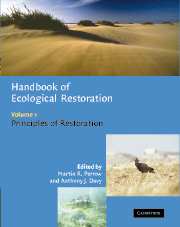Book contents
- Frontmatter
- Contents
- List of contributors
- Foreword
- Preface
- Part 1 The background
- Part 2 Manipulation of the physical environment
- Part 3 Manipulation of the chemical environment
- 9 Manipulating the chemical environment of the soil
- 10 Chemical treatment of water and sediments with special reference to lakes
- 11 Atmospheric chemistry
- Part 4 Manipulation of the biota
- Part 5 Monitoring and appraisal
- Index
- References
10 - Chemical treatment of water and sediments with special reference to lakes
Published online by Cambridge University Press: 29 December 2009
- Frontmatter
- Contents
- List of contributors
- Foreword
- Preface
- Part 1 The background
- Part 2 Manipulation of the physical environment
- Part 3 Manipulation of the chemical environment
- 9 Manipulating the chemical environment of the soil
- 10 Chemical treatment of water and sediments with special reference to lakes
- 11 Atmospheric chemistry
- Part 4 Manipulation of the biota
- Part 5 Monitoring and appraisal
- Index
- References
Summary
INTRODUCTION
The impact of human activities on the aquatic environment has increased during the past century. Chemical pollutants have increased in rivers, lakes and coastal areas due to rising population densities, farming and industrialisation. The effects have included acid rain and acidification of surface water over large areas where catchment soils as well as bedrock are poor in limestone, and increased deposition of heavy metals and other chemicals causing contamination and bioaccumulation of toxic products. A marked increase in the use of pesticides and the enhanced production of organic substances used in various industries have led to increased pollution by a wide variety of organic micropollutants (Kristensen & Hansen, 1994).
Measures to combat industrial sources of pollutants have been implemented at least in some parts of the world, although improvements in many areas are still needed, just as the environmental impact of many organic micropollutants remains to be elucidated (Kristensen & Hansen, 1994). However, the influence from nutrient-rich wastewater from cities or aquaculture and the use and leaching of fertilisers in agriculture still constitute significant problems that often overshadow other environmental problems. Apart from more local industrial influences, increased nutrient loading, resulting in eutrophication and a loss of the natural functionality of many ecosystems, is considered to be the most important and widespread environmental problem of lentic and coastal waters.
- Type
- Chapter
- Information
- Handbook of Ecological Restoration , pp. 184 - 205Publisher: Cambridge University PressPrint publication year: 2002
References
- 15
- Cited by



